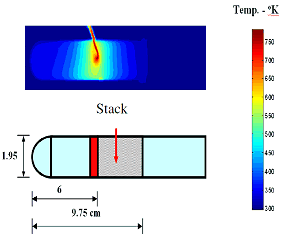|
Thermoacoustic-Piezoelectric Resonators
(Sponsor: King Saud University)
In this project, a multi-disciplinary research and development effort is presented in an attempt to harness efficiently the solar energy and convert it directly into electric power which can be readily used in a multitude of applications.
The direct solar-to-electric energy conversion is based on harvesting the resonant oscillations of acoustic waves generated inside an acoustic cavity by virtue of steep temperature gradients which are developed by concentrating the solar energy on one end of the cavity while the other end is kept at ambient temperature. The resulting gas pressure oscillations, through an optimally sized porous stack, are of the self-sustained type such that heat is given to the oscillating gas at high pressure and removed at low pressure. By this process, heat is converted into acoustic energy and then into electric energy in a reliable manner using piezoelectric bimorphs without the need for any moving components.
The theory governing the operation of thermo-acoustic engines will be developed with particular emphasis on optimally shaping the resonators in order to maximize the power generated and optimize the energy conversion efficiency. Prototypes of the thermo-acoustic engines will be built and their performance will be evaluated with the ultimate goal of developing a product line of thermo-acoustic power generators and thermo-acoustic refrigerators which are directly driven by solar energy concentrators.
To achieve these goals, a multi-disciplinary team is assembled from experts from King Saud University (Riyadh, Saudi Arabia) and University of Maryland (College Park, Maryland, USA) to jointly work on developing the underlying theoretical foundations, devising the design strategies, manufacturing prototypes, evaluating the performance, and transitioning the developed technology to industry.
Examples of TAP engines to be considered are shown below:
Thermo-Acoustic-Piezoelectric Engine (TAP) |
The thermodynamic cycle of the TAP resonator is shown below. At the beginning of the cycle, the acoustic wave compresses the gas parcel (compression). Successively the gas parcel is moved to a hotter part of the porous stack. Since the temperature over is higher than the gas parcel, the gas is heated (heating). Then the gas parcel is expanded by the pressure wave (expansion). Finally, the gas parcel moves back to its original position where it is still hotter than the cavity end resulting in heat transfer from the gas to the ambient (cooling).

Thermodynamic cycle of the Thermo-Acoustic-Piezoelectric Engine |
The emphasis will be placed on supplying the heat to the TAP resonator (engine) through the use of solar concentrators as shown below. The concentrators will be equipped with solar tracking mechanisms in order to ensure maximum resonator output during the entire day.

Harvesting solar energy using Thermo-Acoustic-Piezoelectric Engine |
Simple versions of the thermo-acoustic engine are built without the use of any moving parts as shown below. These versions include a prototype of the standing wave engine is shown and a prototype of the traveling wave version.


Preliminary results of the temperature and flow fields in the prototype of the standing wave engine are shown in the figures below. The temperature field is measured using infrared camera (FLIR – model SC3000) while the flow field measurements, during a complete oscillation cycle of the standing waves, are obtained using LaVision Particle Image Velocimetry (PIV) system. More extensive measurements will be carried out on both the standing wave and traveling wave configurations during the course of the proposed study.

Temperature distribution using infrared imaging |

Velocity distribution inside the TAP engine using PIV |
The figure below displays a schematic drawing of a prototype of the thermo-acoustic refrigerator which is driven by a piezoelectric speaker.

A schematic drawing of a prototype of the thermo-acoustic-piezoelectric refrigerator |
To see the videos, double-click on the image.
QuickTime Format. Quicktime Player required for viewing.
You can download a free player HERE.
Onset of self-excited oscillations |
| |
|
|
Flow field inside standing-wave acoustic resonator |
J. Smoker , M. Nouh , O. Aldraihem , and A. Baz, “Energy Harvesting from a Standing Wave Thermo-Acoustic-Piezoelectric Resonator”, 51st AIAA/ASME/ASCE/AHS/ASC Structures, Structural Dynamics, and Materials Conference, Paper# 2010-3066, April 12-15, 2010, Orlando, FL.
O. Aldraihem and A. Baz, “Onset of Self-Excited Oscillations of Traveling Wave Thermo-Acoustic-Piezoelectric Energy Harvester”, Paper # SMASIS 2010-3879, Proc. of the ASME 2010 Conf. on Smart Materials, Adaptive Structures, and Intelligent Systems SMASIS 2010, September 28- October 1, 2010, Philadelphia, PA.
Top of Page
|

